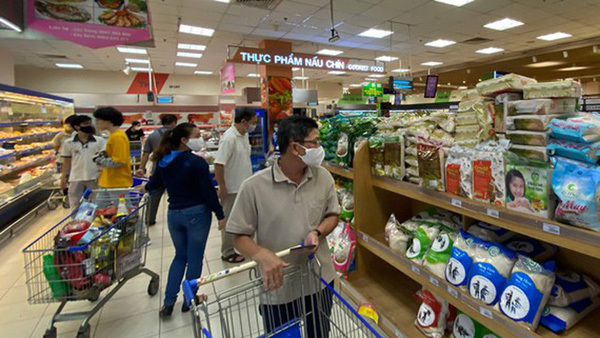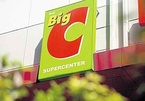 |
| Customers go shopping at Co.opmart Ly Thuong Kiet. (Photo: SGGP) |
A fertile soil
After joining the World Trade Organization (WTO), Vietnam has continuously been among the top countries with the most attractive retail markets in the world for many reasons. Of which, the first factor is the potential from a young population. Therefore, the purchasing power is huge.
In the general picture of the strong economic recovery, retail is considered one of the brightest colors. According to the General Statistics Office of Vietnam, last year, the total retail sales of consumer goods and services increased by 2.6 percent compared to 2019, the lowest increase in the 2011-2020 period, but the market scale still added more than US$11 billion. If the market recovers and continues to maintain a high growth rate as in the past years, within two years from now, Vietnam's retail market will possibly hit $200 billion.
Mr. Nguyen Anh Duc, CEO of Saigon Co.op, said that 2020 was an extremely difficult year for Vietnamese retailers. Not only the Covid-19 pandemic but natural disasters, storms, and floods had also dragged down the purchasing power of the market heavily. Amid this situation, the management board of Saigon Co.op had built many different scenarios to adapt to the new situation, with all the proposed scenarios unprofitable. However, at the end of last year, Saigon Co-op still had a profit, although it did not meet the plan. Revenue was estimated at more than VND33 trillion, equivalent to nearly 90 percent of the plan.
The largest commercial center system in Vietnam, Vincom also recorded that during the Tet holidays, the number of visitors to shopping centers still reached about 80-90 percent compared to 2019. The business report of Aeon Mall Vietnam shows that since the shopping centers were reopened as of April 24 last year, footfall rose again, and from October last year, the number of customers to Aeon Mall exceeded 90 percent compared to 2019.
In 2020, despite difficulties, many FDI retailers had continuously expanded their networks across the country. The most prominent retailer was the fashion brand Uniqlo, which opened five more stores in Hanoi and Ho Chi Minh City; MUJI - a famous Japanese brand also set up its very first store in Vietnam at Parkson Dong Khoi shopping mall in HCMC; Fila sports fashion brand also headed North with the opening of two stores in a row in Hanoi; fashion company H&M also launched two more stores in Ha Long and Can Tho cities, bringing the total number of H&M stores in Vietnam to 11, while it had just closed 250 stores globally due to the Covid-19 pandemic. In the culinary sector, the Chinese hot pot brand Haidilao Hot Pot also opened three consecutive stores last year, all in large shopping centers.
Mr. Tadashi Yanai, President cum CEO of Fast Retailing Group, the parent company of Uniqlo, assessed that Vietnam has great potential and will be one of the largest consumer markets in the world.
The time of modern retailing
According to Mr. Nguyen Anh Dung, Senior Director of Retail Intelligence of Nielsen Vietnam, the retail picture in 2020 has been changing a lot, especially the portrait of buyers, which will continue to occur more strongly in 2021. The retail market in modern channels, such as supermarkets and stores, still achieved positive growth last year, and this distribution system will continue to be the driving force of the growth of the fast-moving consumer goods market in 2021, as well as the near future.
It is recorded by the reporter of SGGP Newspaper, in 2020 and up to now, several stores trading clothing, footwear, souvenirs, cosmetics, and food at wet markets in Ho Chi Minh City are still closed to wait for customers. Meanwhile, convenience stores, supermarkets, and shopping centers continued to develop and diversify sales methods in the direction that is most beneficial to consumers. The shift in Vietnam's retail structure from traditional commerce to modern retail channels has been taking place deeply, especially in large cities, like HCMC and Hanoi.
Mr. Nguyen Anh Duc admitted that the Covid-19 pandemic had made the retail market more divided. On the positive side, it helps retailers identify and focus more on their target customers. The rate of transformation of high-end customers is 4-5 times higher than in previous years. This is the reason why Saigon Co-op must promote a new image, along with high-end supermarket chain Finelife in large cities to serve more high-end customers in 2021. This flexibility to kick-off for the strategy in the next three years, in which Saigon Co-op will have 100 supermarkets specializing in high-end products in the market. At the same time, this year, Saigon Co.op plans to expand 10 retail models in the market and diversify the retail models to best meet all the customer segments.
Racing against domestic enterprises, foreign retailers have also planned to invest, upgrade, and develop more new points of sale. Aeon Mall Vietnam revealed that by 2025, Aeon Group would develop 20 shopping centers in Vietnam. To realize that, Aeon Mall has prepared a capital source of up to $2 billion for investment, striving to export $1 billion of goods from Vietnam to Japan and other countries. According to Mr. Nakagawa Tetsuyuki, CEO of Aeon Mall Vietnam Co., Ltd., in the business of shopping mall chains in Asian countries, Vietnam is the country with the earliest recovery, thanks to efforts to effectively cope with the pandemic.
Without revealing the detailed figure, Central Retail Vietnam has invested a lot in the transformation of the new brand identity from Big C to Tops Market and hypermarket Go! in Vietnam, with a completely new look, along with improving shopping space and service quality in order to bring new experiences to customers. Besides, Central Retail Vietnam also opened hypermarkets to cover points of sale in many provinces and cities across the country.
SGGP

Retail market slumps, global supermarket chains leave Vietnam
Big C, Metro, Tran Anh and Vien Thong A, once powerful retail giants, have disappeared after takeover deals.